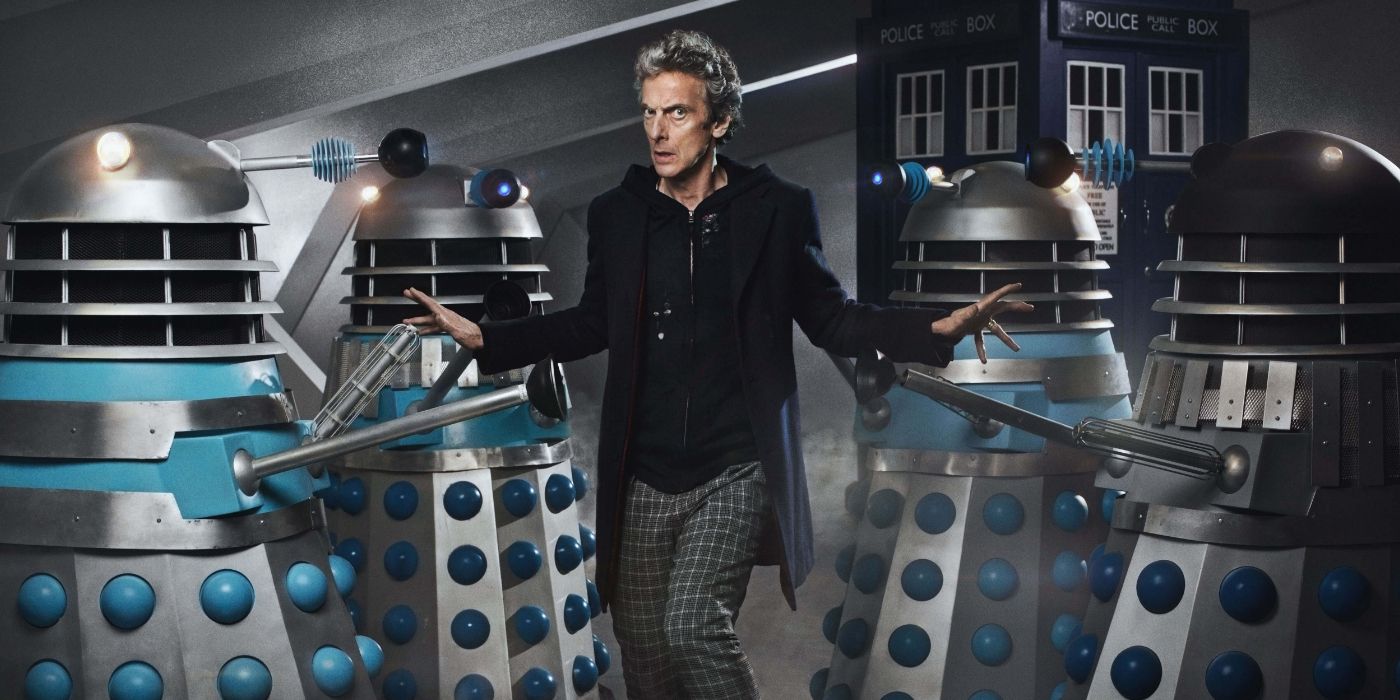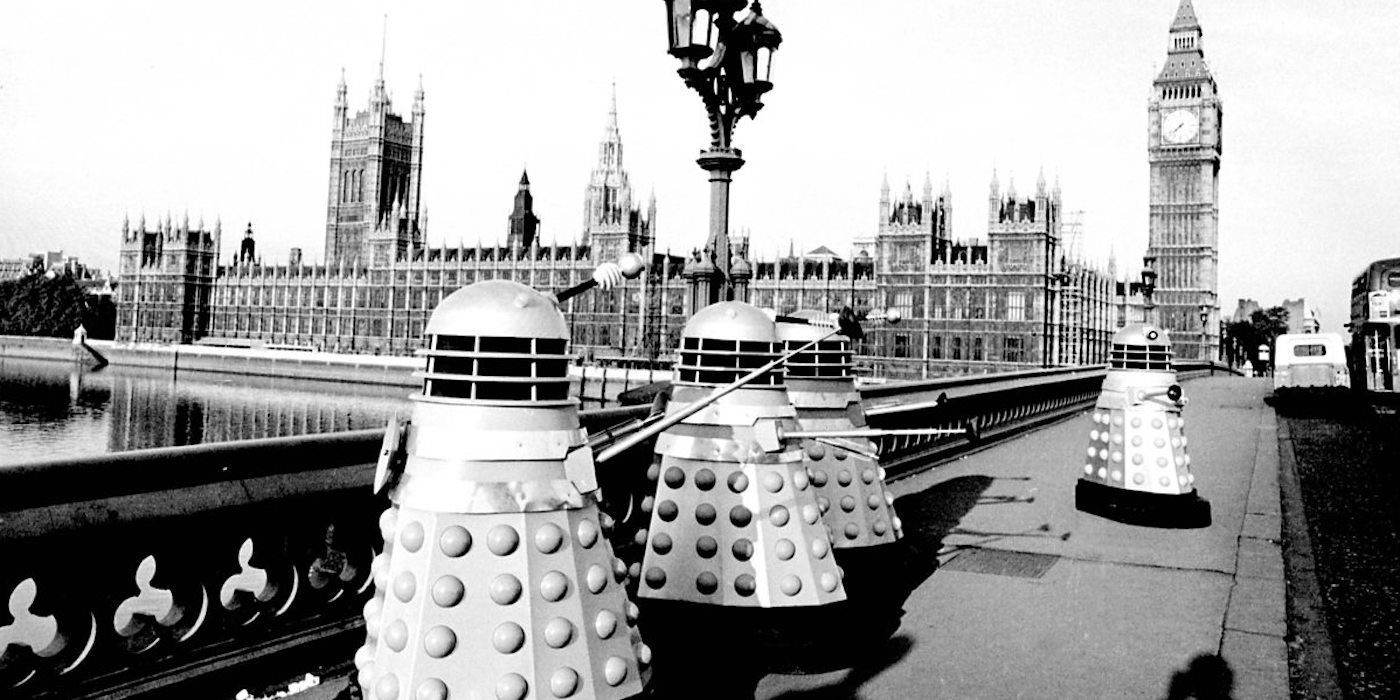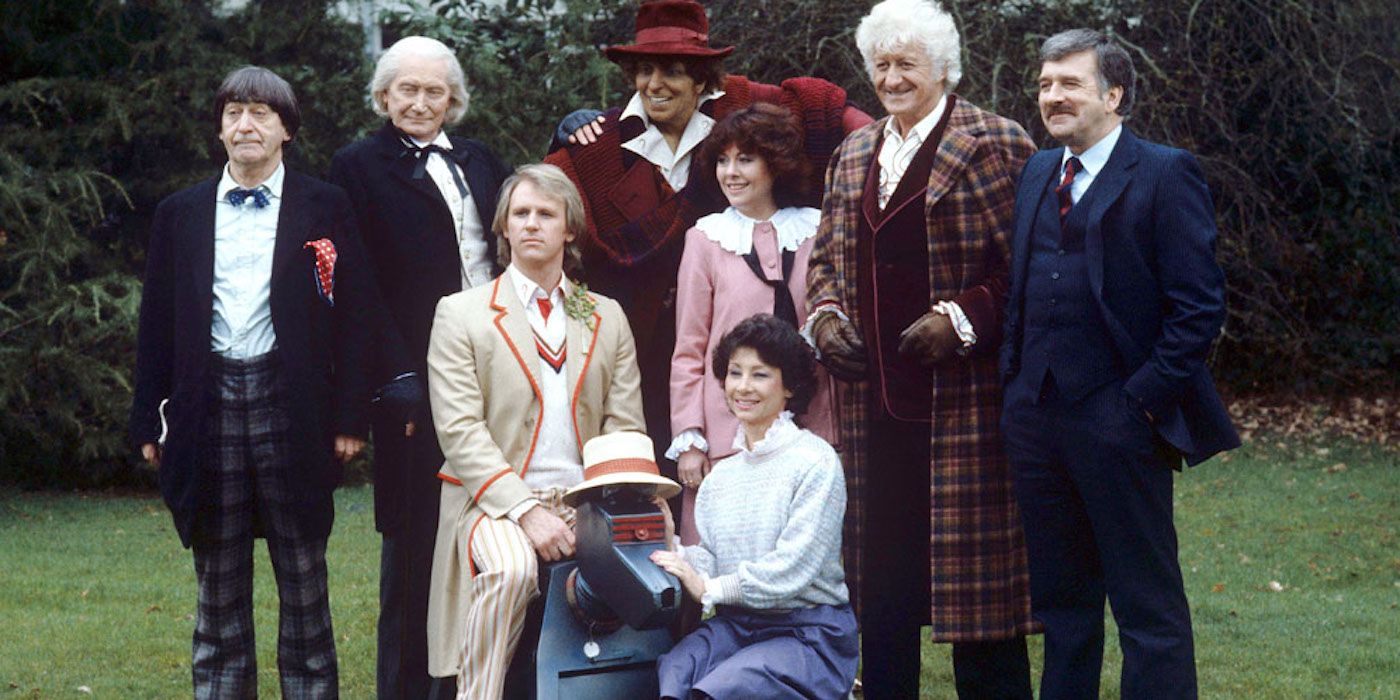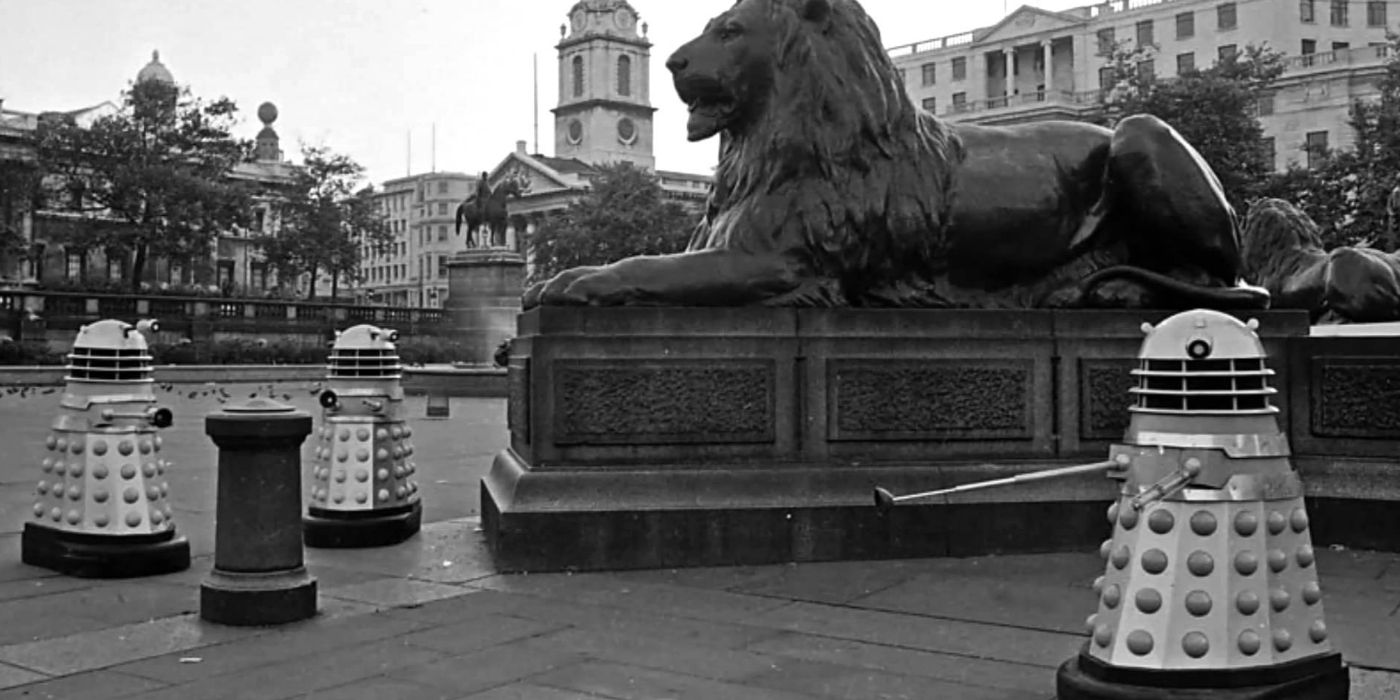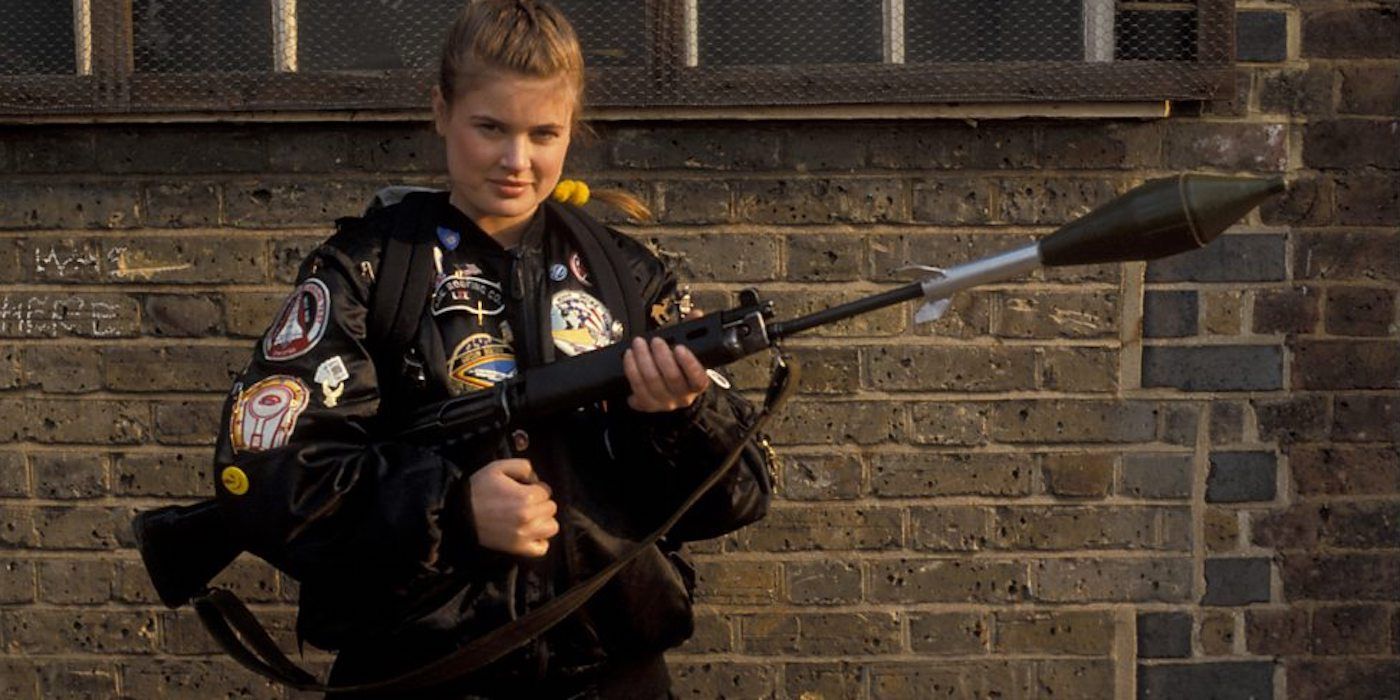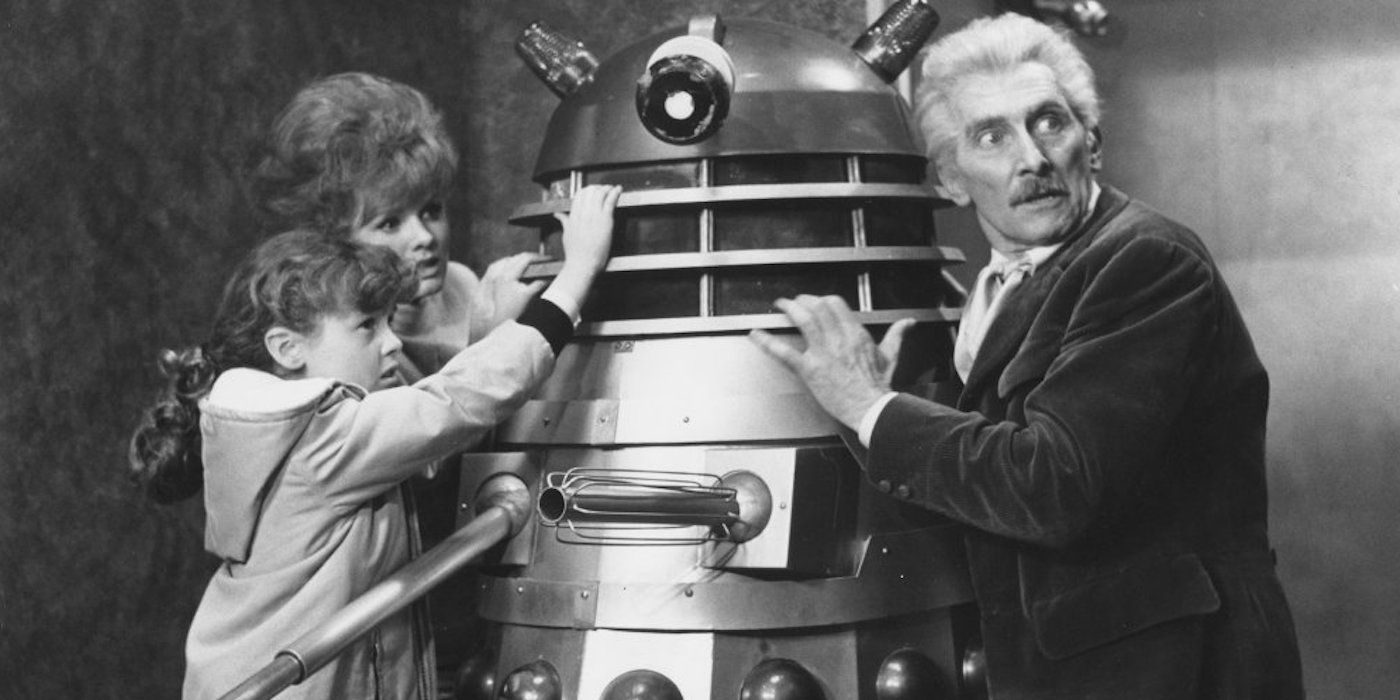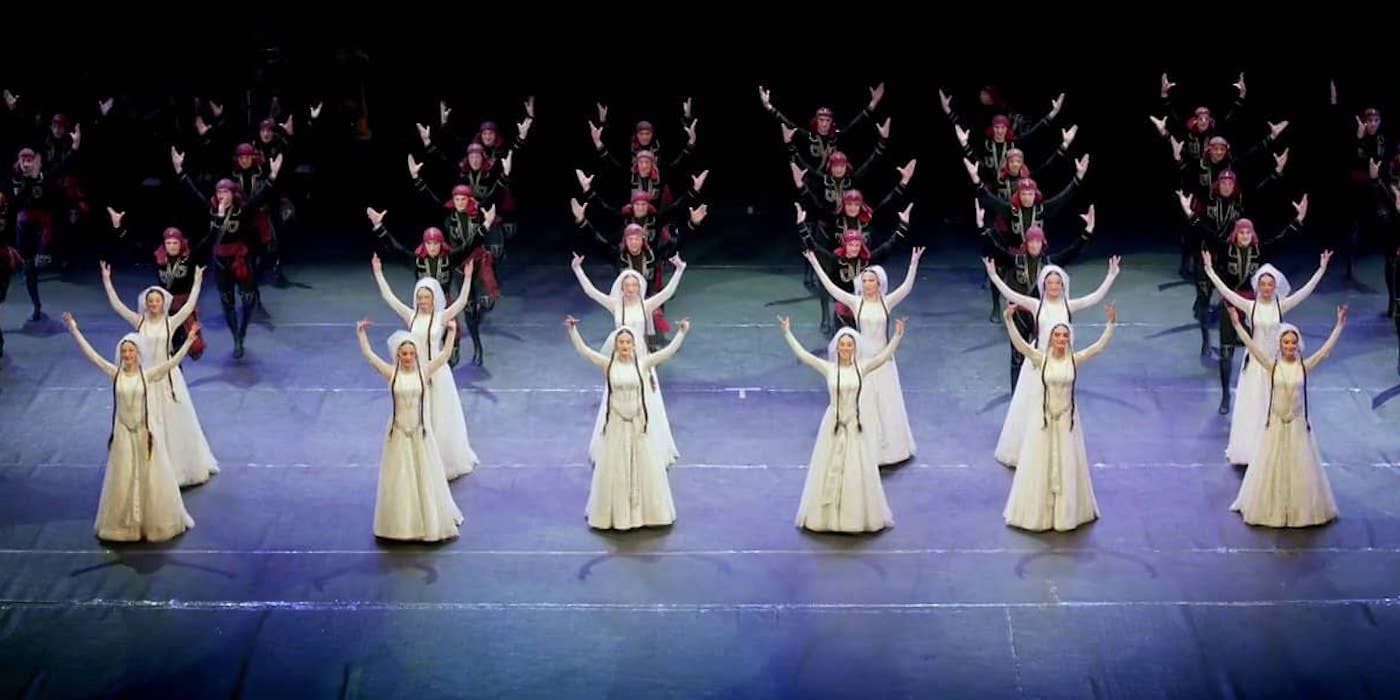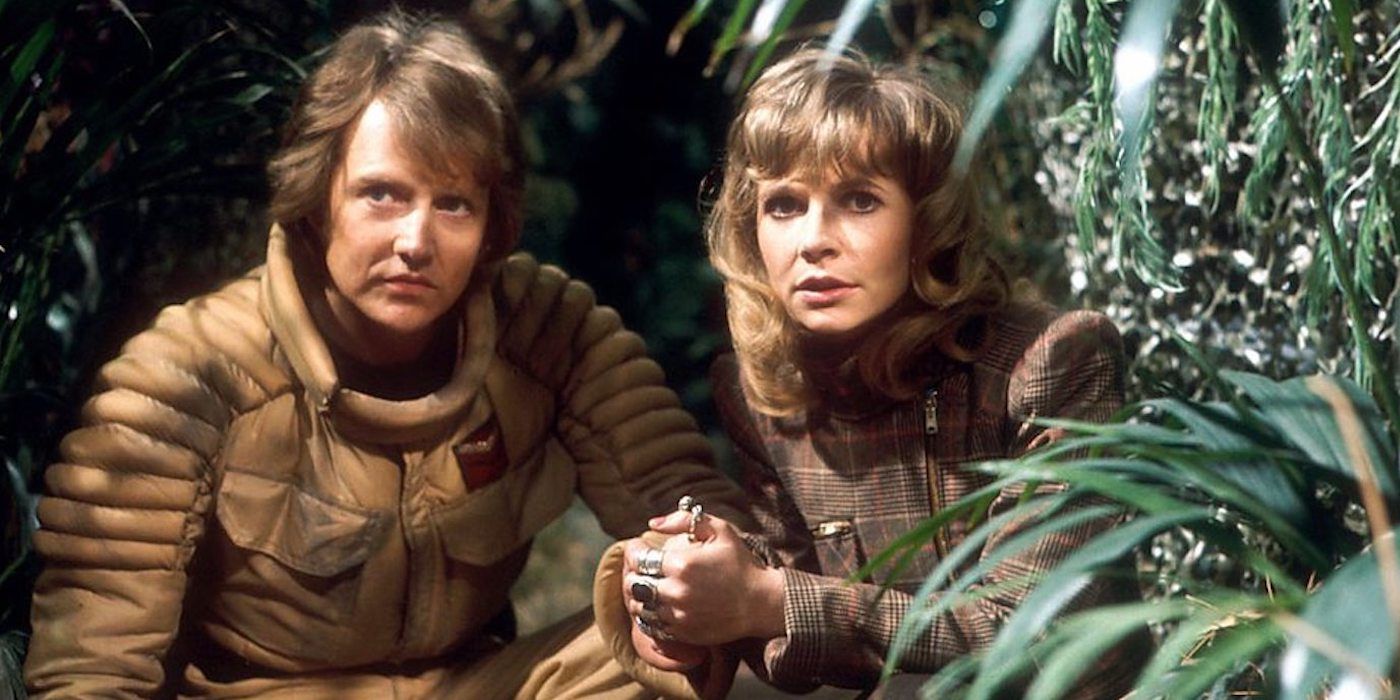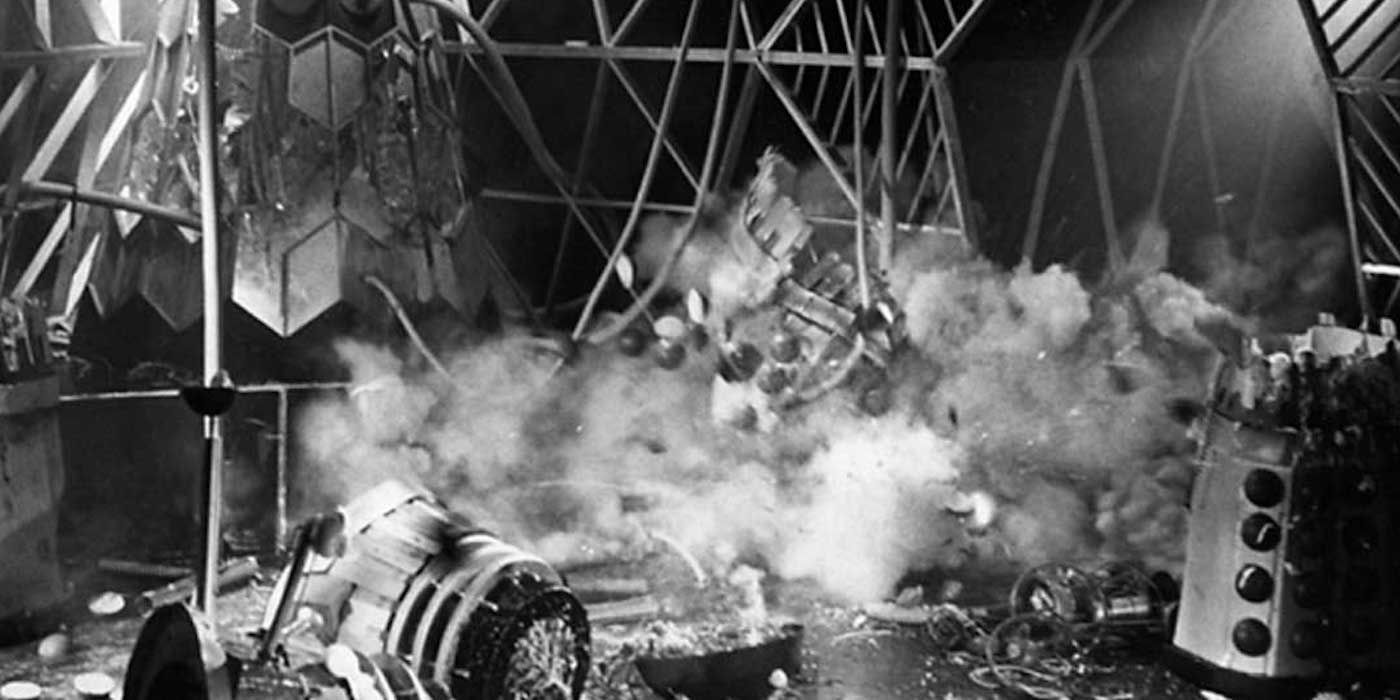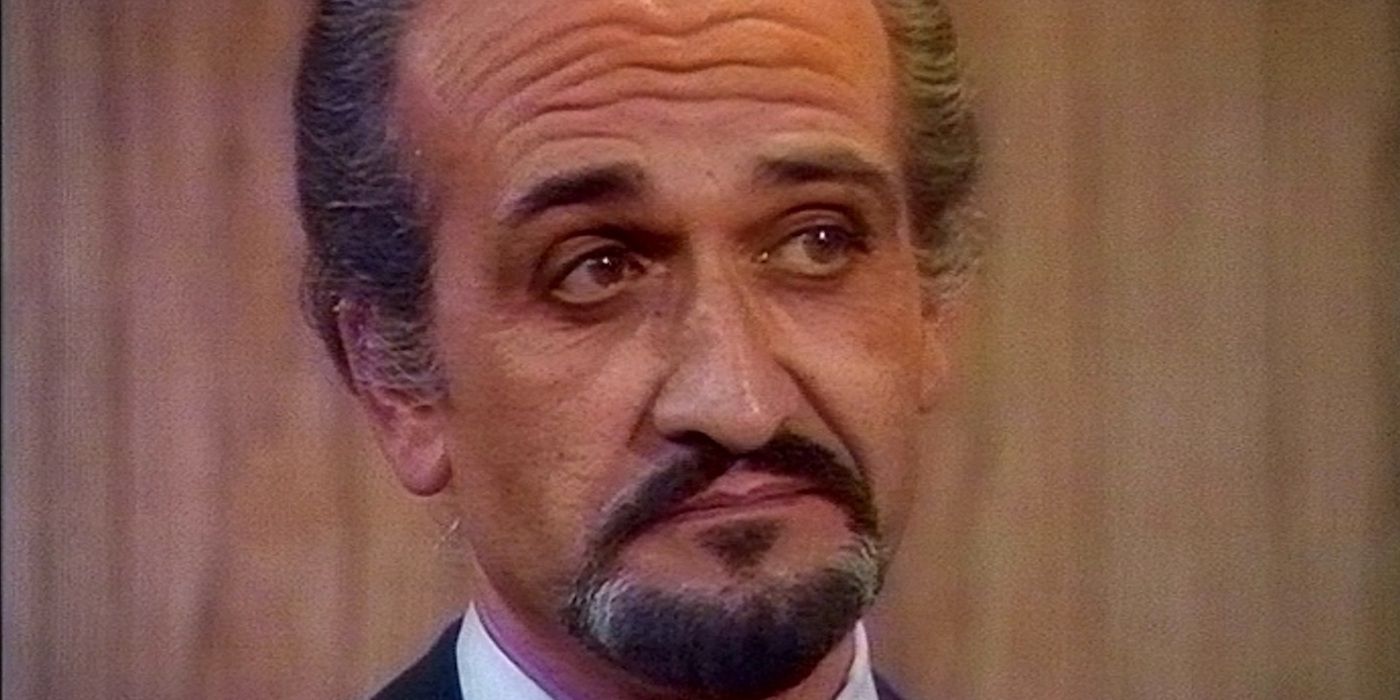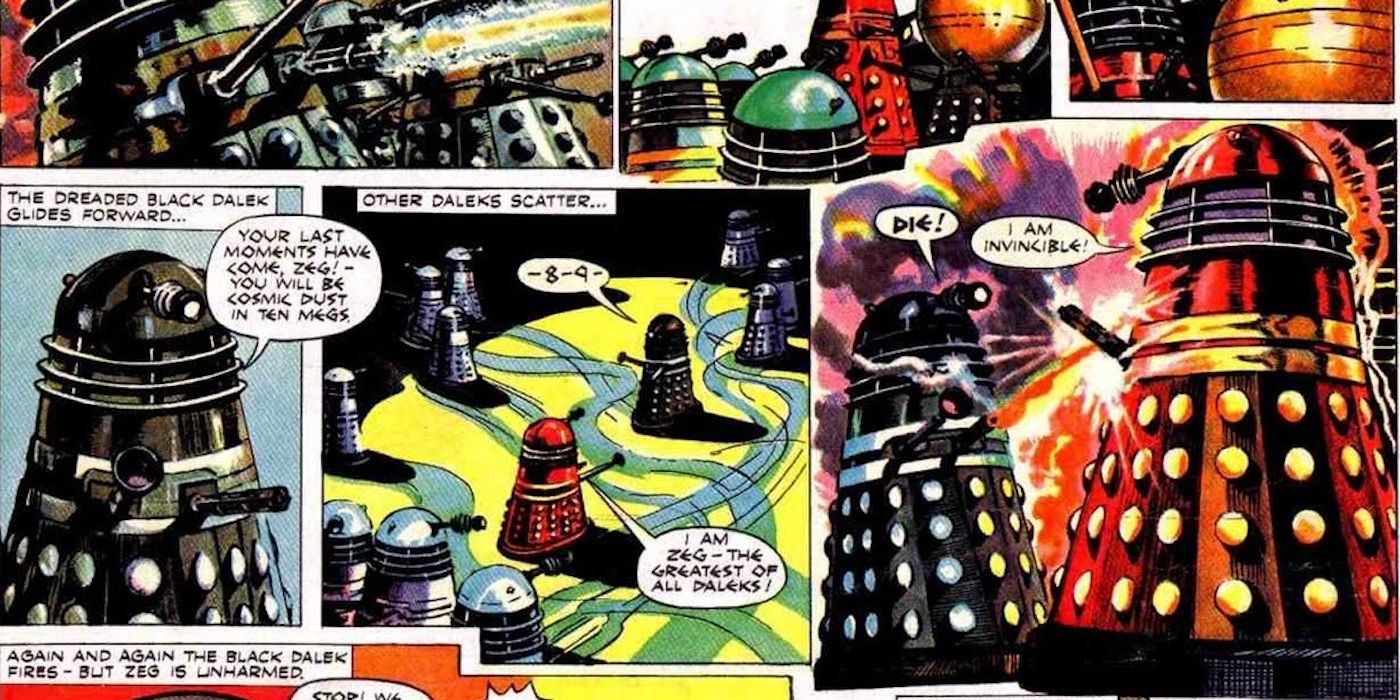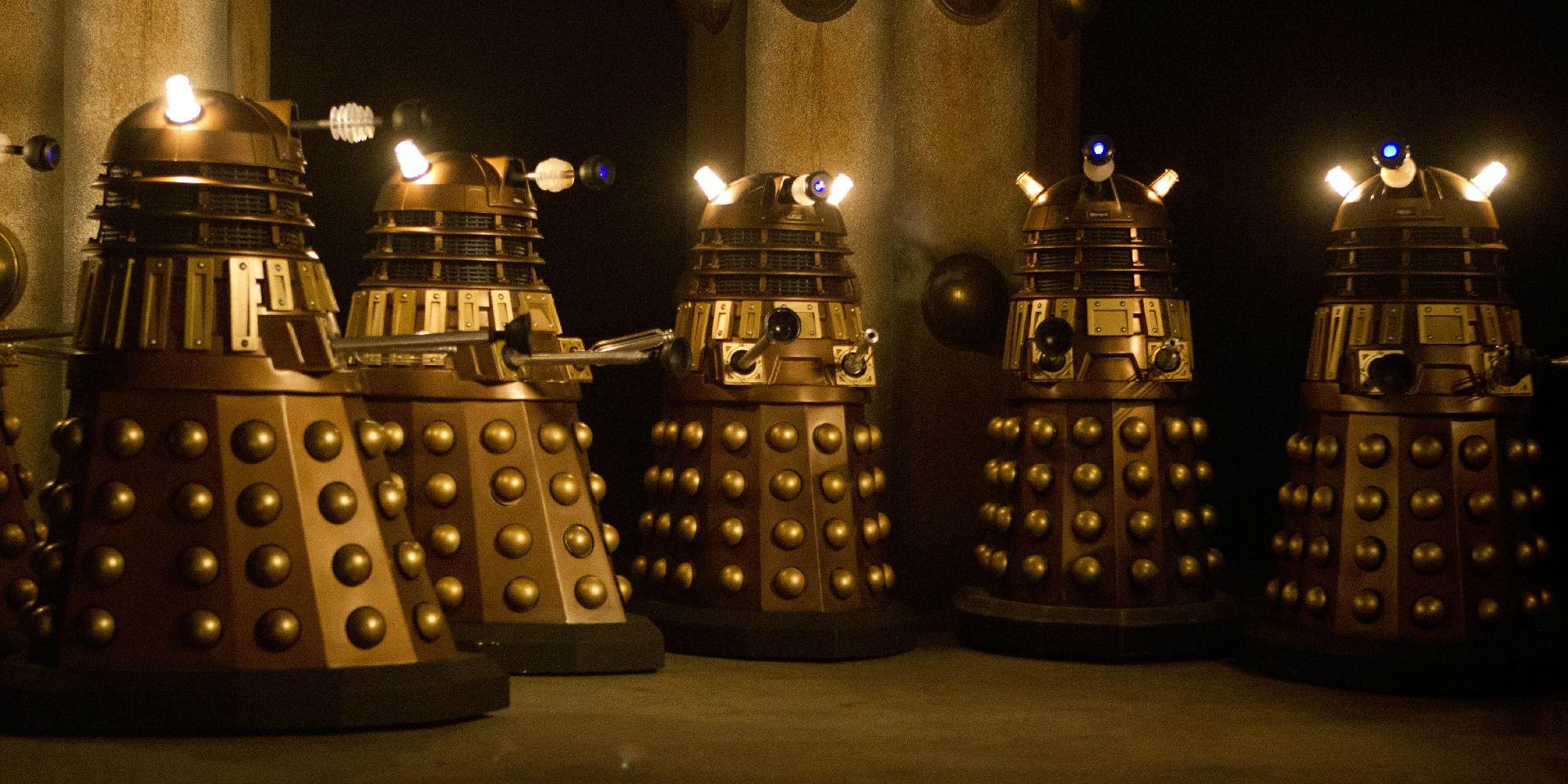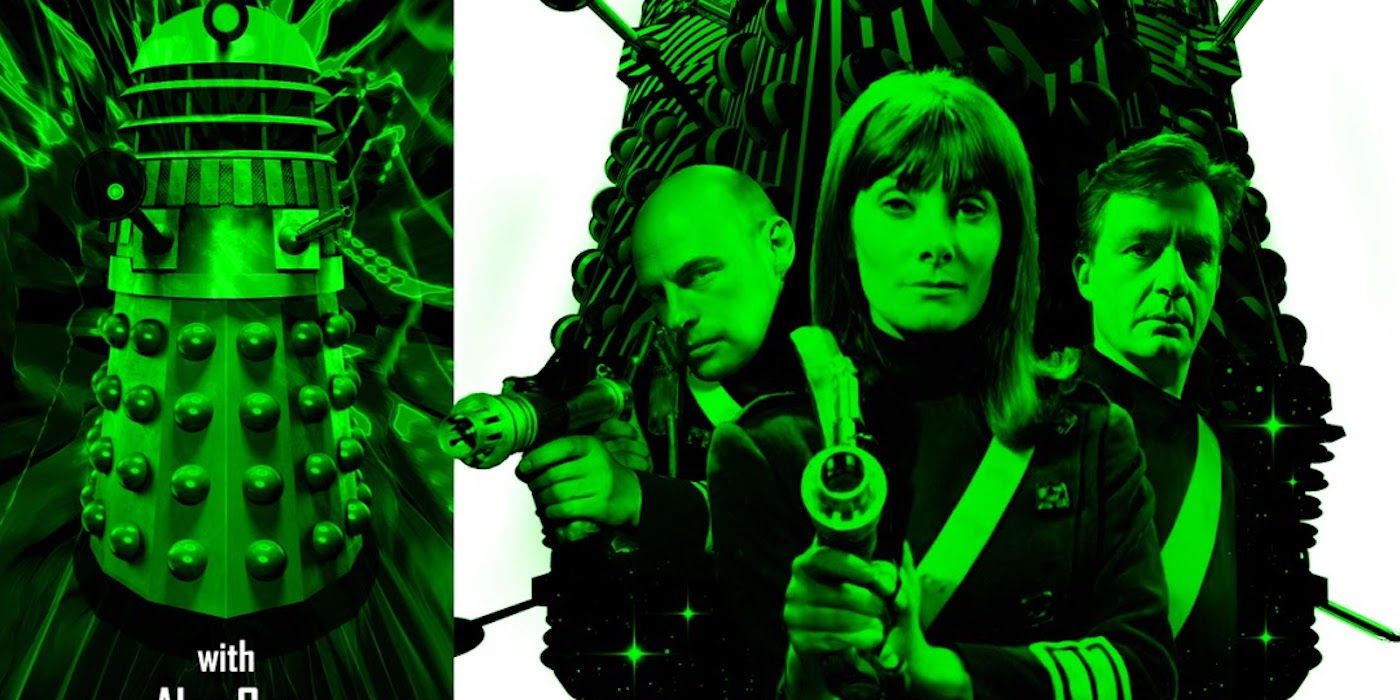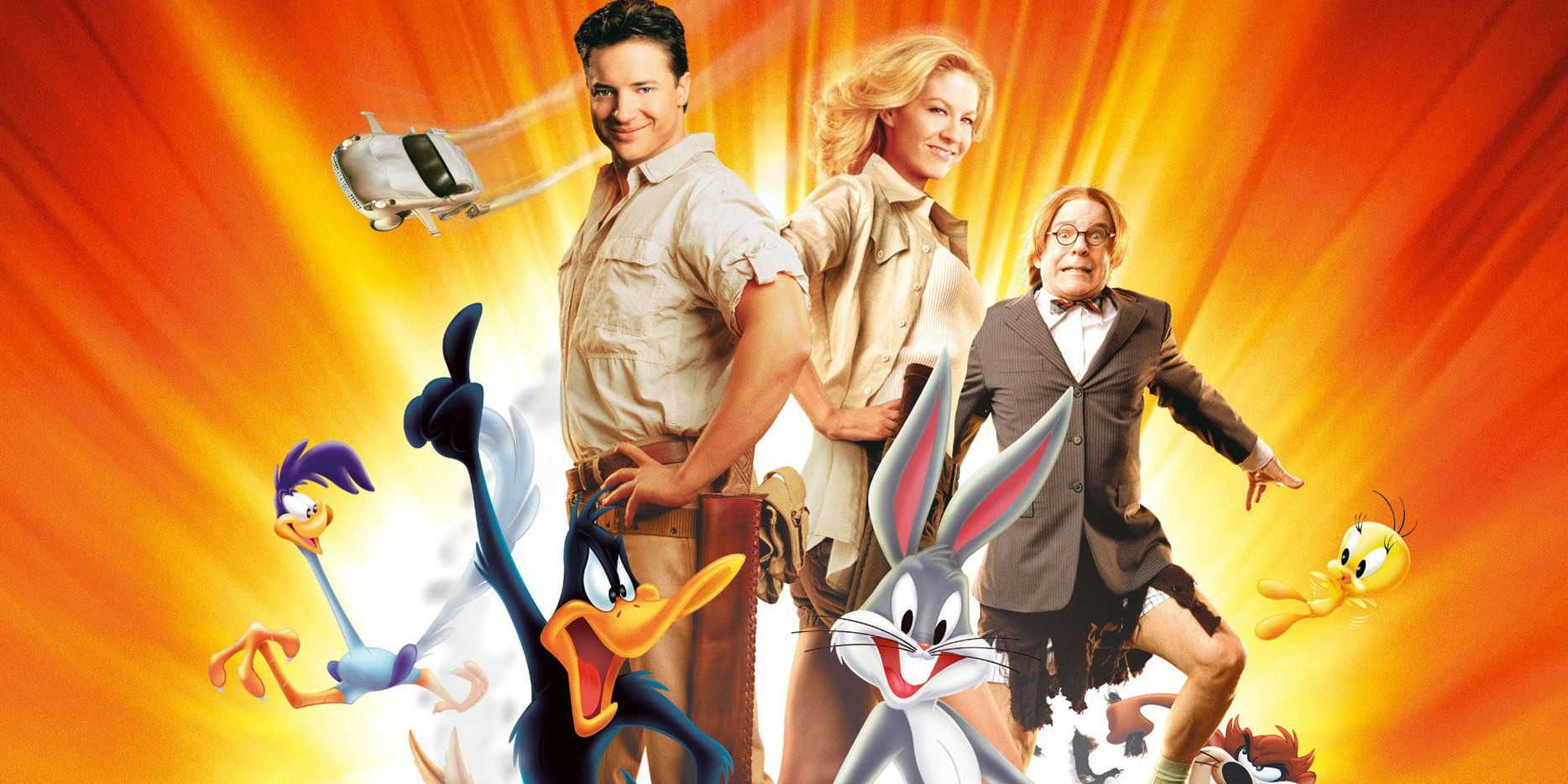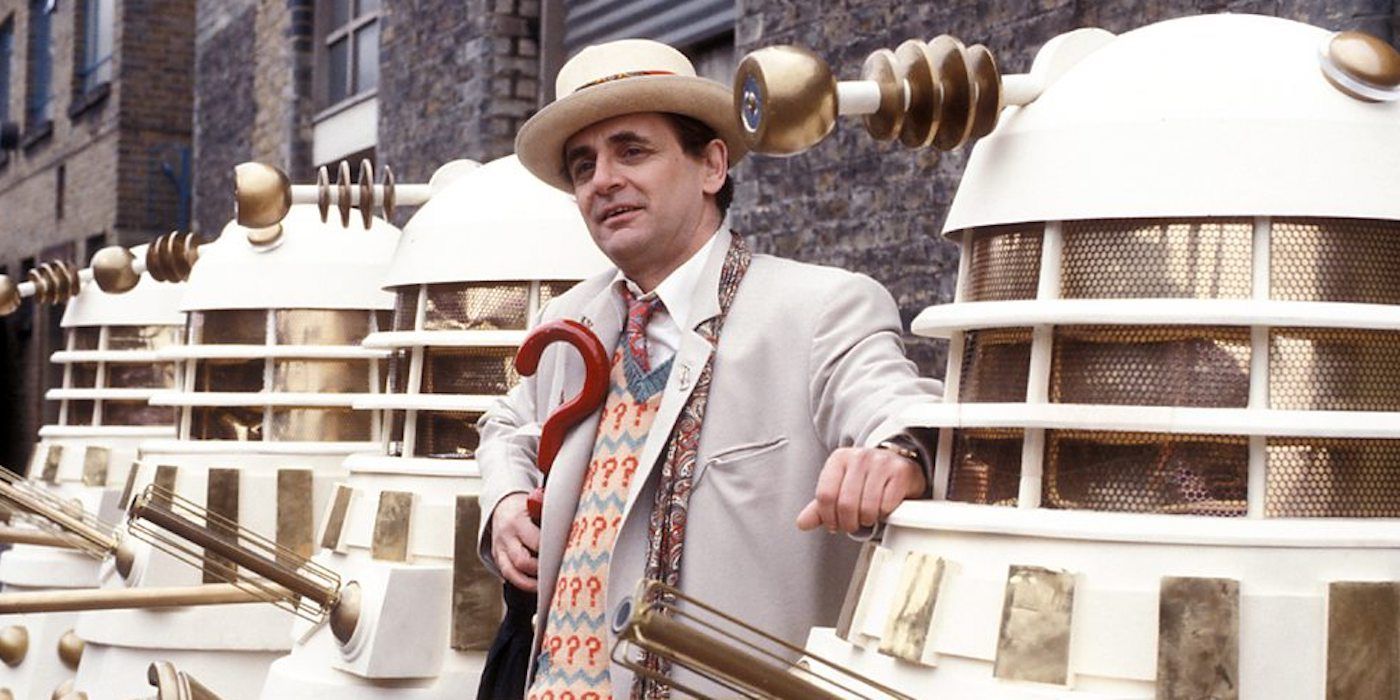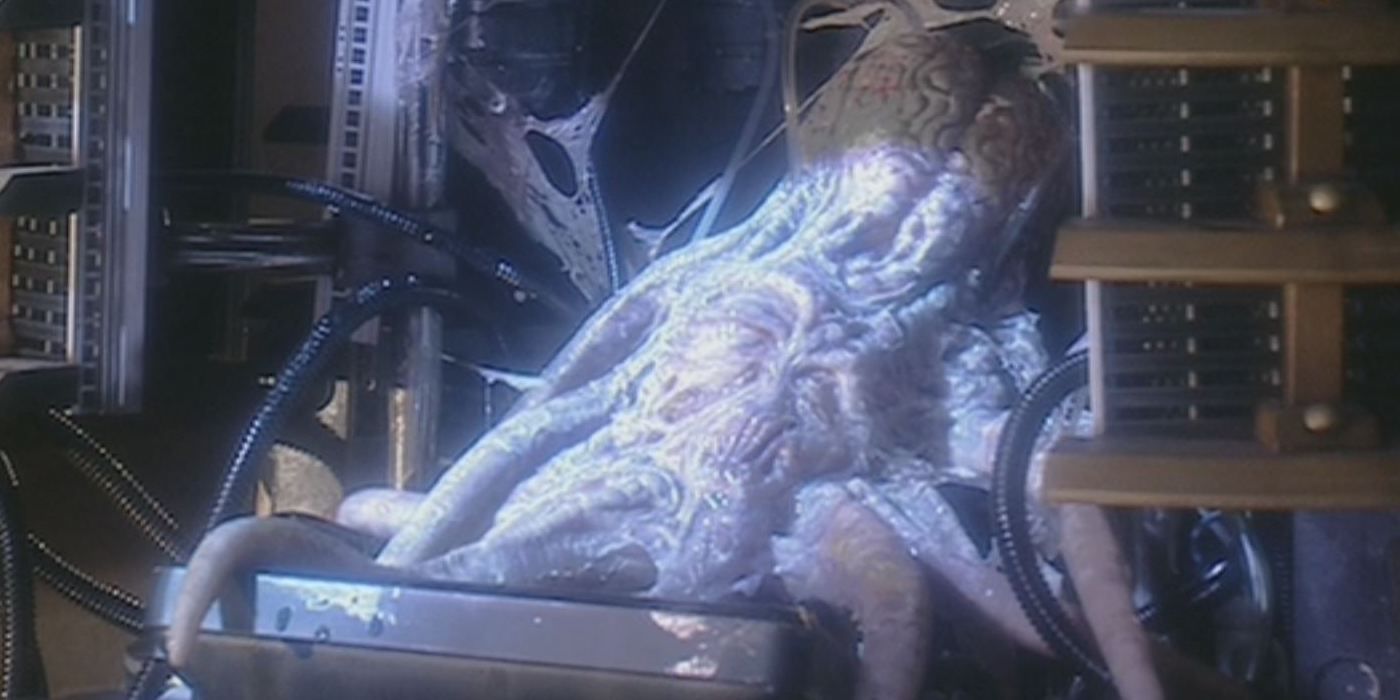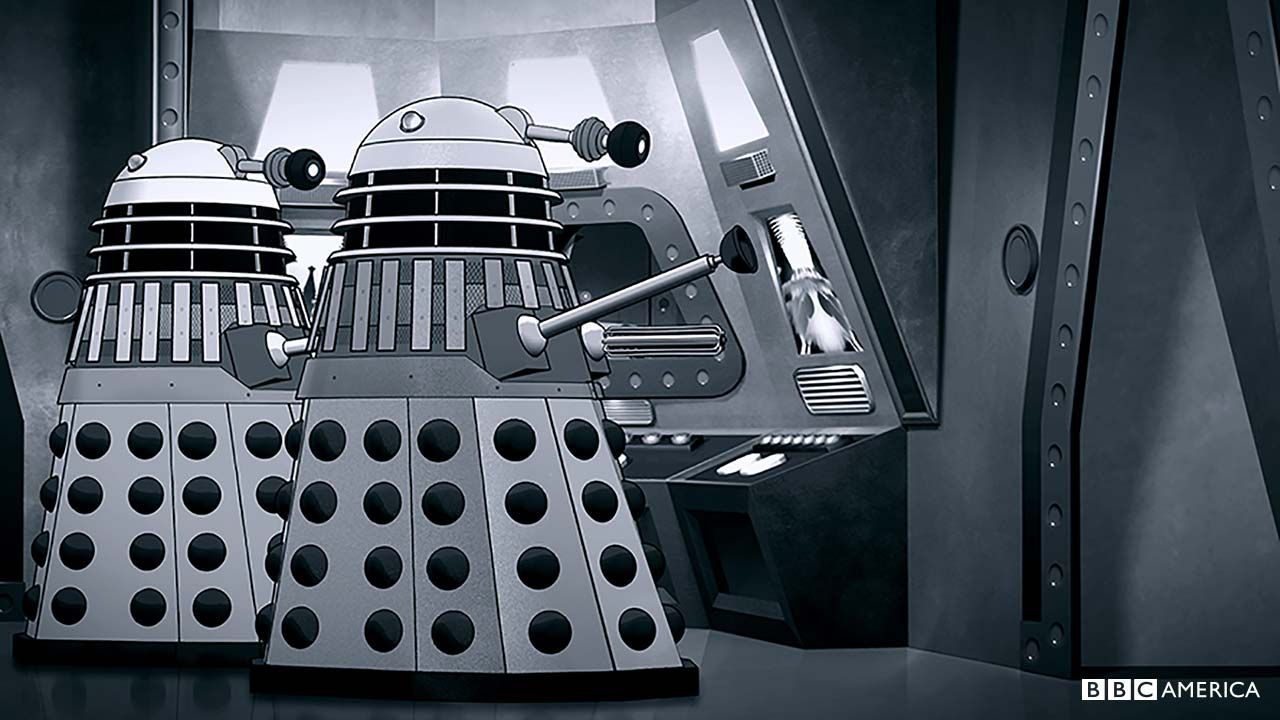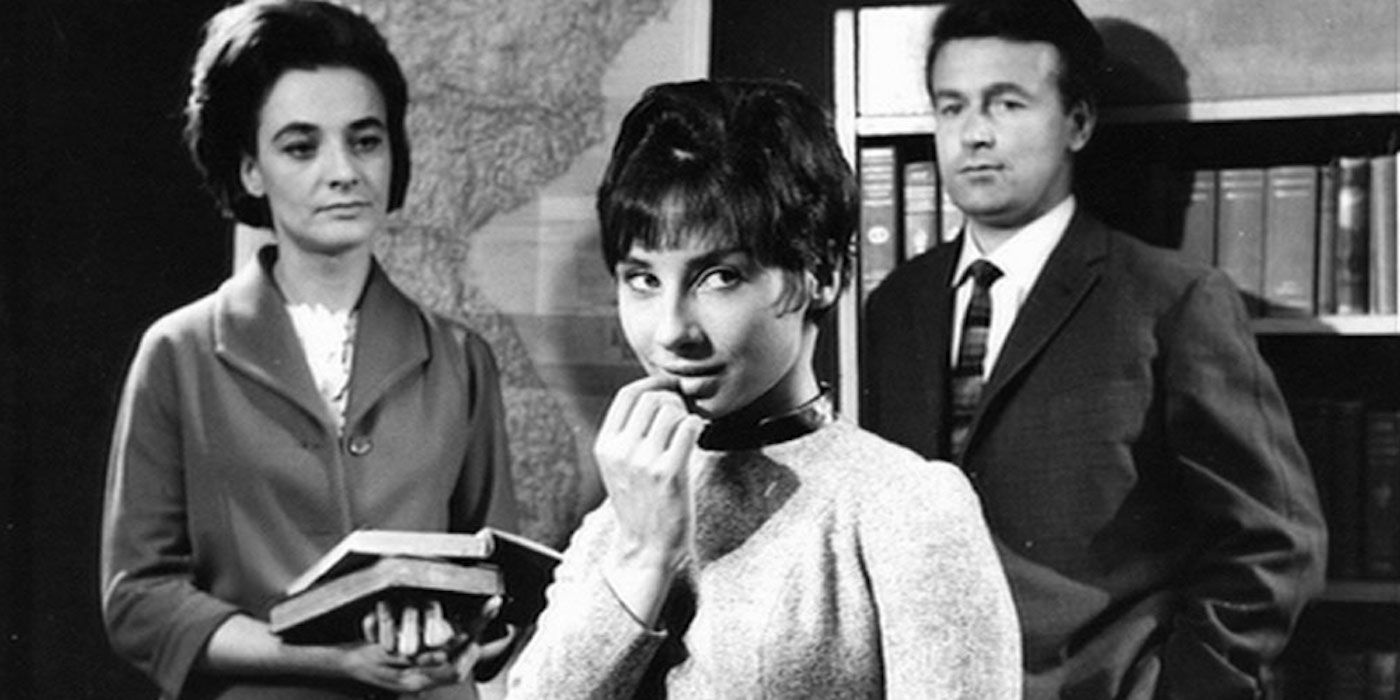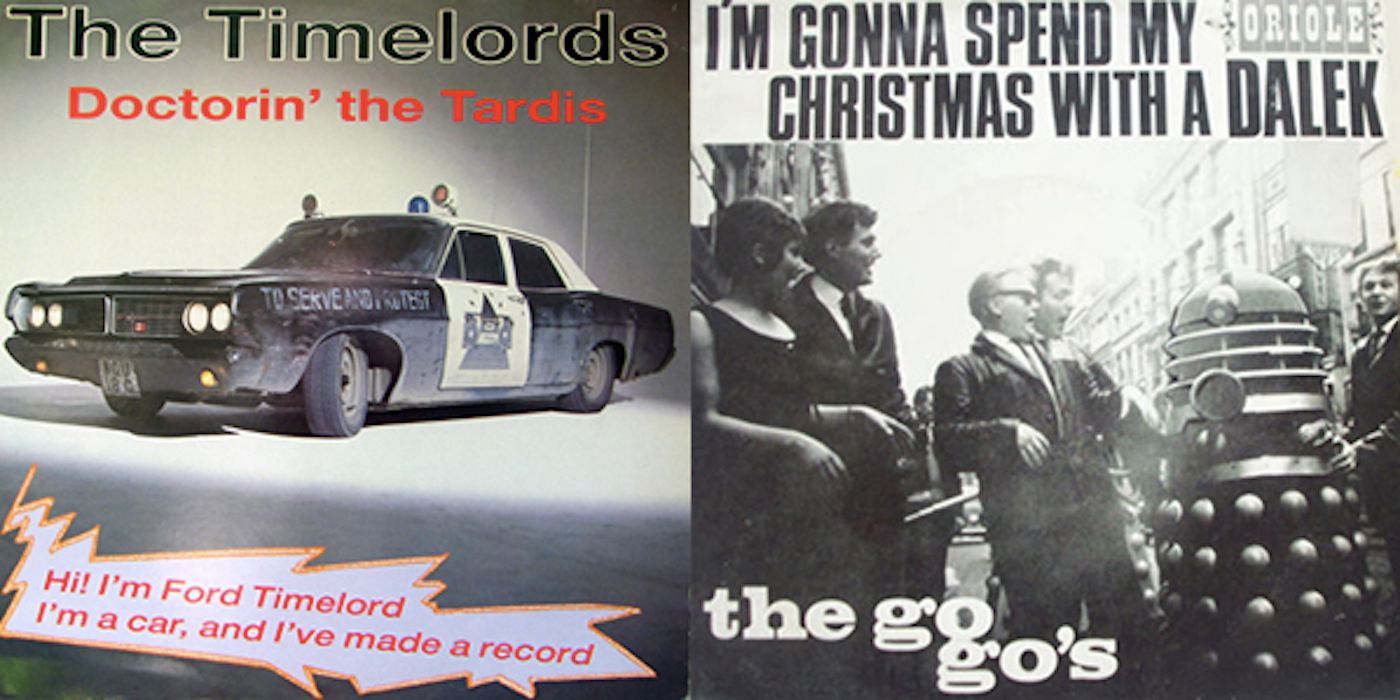“Ex-ter-min-ate! Ex-ter-min-ate!”
When the Daleks debuted in Doctor Who’s “The Daleks” in 1963, TV audiences had seen anything like them. In an age when state of the art extraterrestrials were men in makeup, the Daleks didn’t look, move or sound like anything human. They were the most ruthless aliens anyone would see until the Borg: they didn’t show mercy, they didn’t have compassion or sympathy, and they never questioned their orders. As scriptwriter Terry Nation put it years later, they’re “that unhearing, unthinking, blanked-out face of authority that will destroy you because it wants to destroy you.”
Conceived by Nation and designed by Raymond Cusick, the Daleks appeared in Doctor Who’s second serial and sealed the show’s success. The story ended with them destroyed, but via the magic of time travel and viewer popularity, the Doctor kept running into them. Even without the Doctor as an adversary, the Daleks have had success in other media. Read on for the history of the alien menace that eats Klingons and Imperial Storm Troopers for breakfast.
18) The Daleks have conquered Earth twice
Lots of alien and human schemers have tried taking over the world in classic Doctor Who. The Daleks were the only ones who pulled it off. And they did it twice.
In “The Dalek Invasion of Earth,” the Doctor and his companions arrive in 22nd century London and discover that the Daleks have become Earth’s masters. Humans are reprogrammed into living robots or used as slaves on a mysterious mining project. The Doctor discovers that Earth is only a means to an end: the Daleks plan to convert it into a giant world-ship that they will use to conquer the universe. Allied with the resistance, the TARDIS team puts a stop to that.
1972’s “The Day of the Daleks” once again gave viewers a 22nd century ruled by the Daleks, though it appears to be a different timeline (the Daleks were a late addition to the original script concept). Time travelers from the Dalek-ruled future appear in the present to kill the warmonger who left humanity too weak to fight off the Daleks. The Third Doctor makes the travelers see that it’s their attacks that created their own timeline, then helps them prevent it.
17) Even the Time Lords are intimidated by the Daleks
When the Doctor's people, the Time Lords, first appeared in 1969, they were a reclusive race with no interest in the Daleks or anything else beyond their world of Gallifrey. That concept changed as the series kept using them.
In 1983’s “The Five Doctors,” for instance, viewers learned that the early Time Lords had been vicious as hell. Just for kicks, they used their time technology to pluck aliens from throughout time-space and drop them in Gallifrey's Death Zone. Then they'd sit back and watch them struggle to survive. The only aliens who were off-limits were Daleks and Cybermen — the Time Lords considered them too dangerous to toy with.
So it’s not surprising that when the Time Lords went to war, it was with the Daleks. The Time War explained the long stretch between the original series’ cancellation in 1989 and the revival in 2005: the Doctor had been embroiled in Gallifrey’s war against the Daleks. Ultimately, he’d led the Time Lords to victory, but at the cost of rewriting history and almost wiping out both sides. His anguish over his actions was what made the 21st century Doctor darker than his previous incarnations.
16) Dalek armies sometimes numbered as few as three
The one enemy guaranteed to whittle Dalek armies down to a handful? The BBC suits.
Classic Doctor Who operated on a shoe-string budget. To a lot of people at the BBC, it was a silly children’s show, nothing to shower big bucks on. For many fans of the original series, the cheap look was part of the charm (or so they insisted). When the script called for a Dalek army to attack, though, it could be less charming and more frustrating.
In the climax of “Day of the Daleks,” for instance, the Daleks traveling back through time in an all-out attack to preserve their future. It had been five years since the Daleks were supposedly wiped out (see entries 11 and 7 below) and the BBC had just enough Dalek pieces in storage for three robotic monstrosities — which is actually fewer than the number that appeared in a 1960s stage play, Curse of the Daleks. As even the BBC admits, it was a major flaw in an otherwise first-rate story.
15) Daleks once allied with 1960s British white supremacists
“Remembrance of the Daleks” is a very meta Seventh Doctor arc. It's set back in November of 1963, the month the series began — in fact, Ace, the Doctor’s companion, almost catches the first episode. The show visits the junk yard where the TARDIS first turned up, as well as Coal Hill School, which the Doctor’s granddaughter attended for a while. Amidst all the winks and nods, the show also tackles 1960s British racism.
The storyline involves two rival groups of Daleks struggling for a super-weapon the Doctor has hidden in the area. One side has joined forces with the Association, a fascist, white-supremacist organization that believes the Daleks can help them take control of Britain. Immigration from Britain’s Caribbean colonies had boomed in the 1950s, and many working-class whites of the era resented it.
Ace is largely ignorant of the racist side of recent history. Then, she discovers that Mike, a soldier she’s been flirting with, is part of the Association, and that Mike's mother’s charming little boarding house has a sign out saying “No coloreds.” She's horrified.
Unsurprisingly, teaming up with Daleks ends horribly for Mike and the Association. Nobody can say they didn’t deserve it.
14) The Daleks Battled Grand Moff Tarkin
No, the Daleks never invaded the Star Wars universe, at least not outside of fanfiction. But when the Doctor and the Daleks came to the big screen in the 1960s, the producers recruited the future Grand Moff Tarkin, Peter Cushing, to play Doctor Who (unlike TV, his name really is Who).
By 1965, the Daleks were at the peak of their popularity. Milking their fame for a movie must have seemed a smart move to producer Milton Subotsky, who struck a deal with the BBC. Doctor Who and the Daleks (1965) and Daleks: Invasion Earth 2150 AD (1966) adapted the first and second Dalek serials respectively. It shows the power of their name that "Who" wasn’t even in the title of the second film.
Rather than rely solely on Dalek power, Subotsky hired Cushing, an established screen star thanks to his horror work with Hammer Films. As Hammer's Dr. Frankenstein (and A New Hope's Tarkin) Cushing displayed an arrogance and confidence similar to William Hartnell's First Doctor. As Who, however, Cushing is gentler and quieter; a lovable grandfather rather than a family autocrat. How these films fit into the regular Who-canon (or if they do) is something fans can entertain themselves arguing over.
13) The Daleks gliding movements were inspired by ballet dancers
When Nation and Cusick initial developed the Daleks, they didn’t want Doctor Who’s first alien race to be obvious humans in makeup. Nation’s script describes them as “hideous, machine-like creatures. They are legless, moving on a round base. They have no human features. A lens on a flexible shaft acts as an eye, arms with mechanical grips for hands." The script establishes that the machines are just a shell around the heavily mutated creatures preserved inside.
Part of what makes the Daleks so eerie is their movements — smooth, gliding, with no visible wheels or legs to propel them. In reality, Nation’s inspiration was seeing the women of the Georgia National Ballet glide across the stage in long skirts. This indirectly led to a persistent Dalek legend, that when Cusick sat down to design their look, he based it on a pepper pot in the BBC cafeteria. The BBC website says he just used the pepper pot to show someone how Daleks moved.
A more recent claim is that Cusick based the Dalek design on a distinctive chimney at a Gloucester girls school. Whatever Cusick’s inspiration, there’s no denying that he brought Nation’s concept to perfect screen life.
12) The Daleks share their home planet with their mortal enemies
Although the Daleks have become a TV legend, their hereditary foes, the Thals, are a pub trivia question. (“What race shares the Daleks’ planet of Skaro? A) The Sontarans, B) the Thals …”).
In “The Daleks," viewers learned the two races went to war generations earlier, then went nuclear. The fallout mutated the Daleks to the point that they can't survive without their casings. The Thals, meanwhile, rely on anti-radiation drugs that keep them looking pretty. And pretty forgettable — unlike the Daleks, the Thals appear completely, mundanely human.
It's hardly surprising nobody reused the Thals for a decade. The Third Doctor's "Planet of the Daleks" has a Thal strike force trying to wipe out their ancient foes on the planet Spiridon. If the Thals fail, the planet holds 10,000 Daleks in suspended animation just waiting to thaw out and exterminate the galaxy.
1975 brought the last Thal appearance to date, through chronologically, "Genesis of the Daleks" is their first. The Fourth Doctor arrives on Skaro as the war lurches to its conclusion and the Kaled race begins its transformation into Daleks. The Thals are still less memorable than their enemies.
11) The Doctor has wiped out the Daleks several times, and saved them from annihilation once
From the very first time the Daleks appeared, the Doctor has been down with destroying them. In “The Daleks,” he helps the Thals break into the Dalek city and wipe out their ancient enemies.
Several years later, in “Evil of the Daleks,” the Second Doctor introduces the Human Factor — independent thought — into the blindly obedient Dalek minds. The newly humanized Daleks go to war with the rest of the race, and the Doctor tells his companions this will finally end the Daleks forever (spoiler: it didn't).
In “Remembrance,” the super-weapon the Doctor has hidden is a booby trap. When one of the Daleks activates “the Hand of Omega,” it destroys Skaro, then annihilates the Dalek battle fleet. Of course, this genocide didn’t take any more than the previous two times, or the Doctor’s off-screen destruction of the Daleks in the Time War.
The one time the Doctor resisted wiping them out was in “Genesis.” The Doctor has a clear shot at destroying the first Daleks, but hesitates to wreak havoc on history by erasing them. Eventually, he steels himself to do the deed — and of course, discovers it's too late.
10) The Daleks Allied with the Master, then they killed him
In “Frontier of Space,” the Doctor and companion Jo Grant visit the 26th century, where they discover a scheme to push the Terran and Draconian Empires into war. Eventually, they reveal the villain behind it is that renegade Time Lord, the Master — and he's doing it as a Dalek agent. At least, that's how the Daleks see the Master, as a disposable lackey. The Master mutters to himself that before long, they'll learn who's really running the show.
The Master does not, however, appear in the follow-up serial, "Planet of the Daleks", nor does it appear that the show was planning for a Master/Dalek clash of titans. It wouldn't have happened anyway: Delgado tragically died in a car crash shortly after "Frontier", and it would be almost a decade before the show recast the role.
Apparently, the Master did strike back at the Daleks, but he did so off-screen. The 1996 Doctor Who TV movie opens with the Doctor collecting the Master's remains after the Daleks execute him. It seems that they knew exactly who was running the show.
9) The Daleks had their own comic strip and their own stage play
In the middle 1960s, when British kids were at peak Dalek, the Peter Cushing movies weren’t the only time the Daleks stepped out off the TV screen. A 1965-67 Daleks comic in TVCentury 21 gave the Daleks a chance to shine without the Doctor getting in the way of their evil plans.
The comic strip recounts the Daleks' history, starting with their mutation during the long war with the Thals. It follows their militaristic expansion into the universe, their battles with the robotic Mechanoids, and finally, their discovery of Earth. Despite often taking a Dalek's eye view of the events, the strip made no bones about what treacherous, murderous creatures they were.
As if that wasn’t enough, the Daleks also got to appear on the London stage without the Doctor. Curse of the Daleks has a spaceship crashing on Skaro, but the crew isn't worried — the Daleks have all been destroyed, right?
Well, what do you think the answer is?
8) The BBC doesn't own the Daleks, just their look
Ownership of successful media properties often gets complicated. Scriptwriter Terry Nation, for example, owns the copyright to the Daleks, not the BBC. His contract for also gave him a cut of Dalek merchandising, something "the Beeb" undoubtedly didn't imagine becoming a cash cow.
The Dalek design, however, was Cusick’s. As a BBC employee, that gives the rights on the Dalek’s look to the network — and without the look, would a Dalek be a Dalek? Nation can write Dalek books (and he has) but on screen, it takes two to tango. When the BBC and Nation (or Nation’s estate) disagree on the steps, it’s bad news for fans, as you’ll see in the sixth entry on our list. On the other hand, as who owns what is clear, fans don't have to worry about a copyright lawsuit changing everything.
For anyone who's wondering, co-creator Cusick didn't see any merchandising money for his brilliant work. That's the price of being on staff, instead of freelancing, we're afraid.
7) Efforts to launch a Dalek TV series led to the BBC killing them off
Along with the comic strip, the movies, and the stage play, the Daleks almost had their own TV series in the '60s. Judging from the never-made pilot script, “The Destroyers”, the series would have pitted the Daleks against Sara Kingdom, the tough Space Security agent who’d joined forces with the Doctor in TV’s “Dalek Master Plan.” The pilot ends with Sara captured by the Daleks, learning of their plans against Earth (as she died on TV, this is more an alt. take than a spinoff).
Alas, Nation’s plan to sell the series to NBC fell through, and the BBC backed out of financing the show. Nevertheless, the possibility of a Dalek-centric series led to the villains getting written out of Doctor Who in "Evil of the Daleks." Most sources say that Nation wanted to free them up for the new show. Some accounts say that the pilot’s failure convinced the BBC that the Daleks were yesterday’s villain. Either way, they didn't battle the Doctor again for five whole years.
For inquiring minds, an audio adaptation of “The Destroyers” came out in 2010.
6) A movie cameo almost prevented the Daleks from being used in the show ever again
In 2003’s Looney Tunes: Back in Action, there’s a scene in the government’s “Area 52” (Area 51 is just a myth) showing dozens of familiar aliens, including a couple of Daleks, locked up there. When things get crazy, the Daleks disintegrate Marvin the Martian. It's cute, but because of those scenes, the 21st century's Doctor Who almost lost the use of the Daleks.
After Terry Nation's death in 1997, control of the Dalek copyright passed to his estate. When BBC began negotiating to bring back the villains, the estate demanded the same editorial control Nation had wielded in the past. The BBC said no.
The estate representatives countered by telling the media that they didn't trust the BBC to handle the Daleks properly. For example, the reps said, the BBC had signed off on the Looney Tunes cameo without consulting the estate, and they'd also made plans for a "gay Dalek" cartoon.
Who writer Russell T. Davies told the media that the show would do fine without the Daleks, but fans weren't so sure. Fortunately, they wouldn't have to find out: the BBC and the estate eventually worked out a deal.
5) Daleks can climb stairs
Like many long-running TV shows with enthusiastic fandoms, a number of myths have collected around Doctor Who. For instance, that the original “Daleks” script featured a glass Dalek, or that Terry Nation took the name from a “DAL - LEKS” encyclopedia section (the BBC says both are bogus). Other legends state that the villains themselves were modeled on pepper pots, and most notoriously, that Daleks can’t climb stairs.
It’s understandable why people might assume that last one. The lack of legs or treads that makes the Daleks so eerie also makes them seem to be in desperate need of ADA-compliant buildings. Watching the Dalek serials, though, it becomes obvious that even though the show never shows them navigating stairs, they must be able to. In "Dalek Invasion of Earth", they move around the ruins of London effortlessly. A decade later, they'd maneuver through the jungles of Spiridon with the same apparent ease.
Nevertheless, “Daleks can’t climb stairs” became fan canon, and was even joked about in British humor magazines. One episode of “Remembrance” deliberately riffs on the myth and then dispels it: the Doctor smirks at a Dalek from the top of a staircase, only to see it levitate up toward him.
4) We rarely see them in their true form
The real Daleks, the mutated survivors of Skaro's war, are the creatures inside the casings. Despite all the times the Daleks have appeared on the show, the villainous beings themselves don't get much screen time.
In "The Daleks," the only glimpse of a mutant is the hand of a dead Dalek covered by the Doctor's cloak. It wouldn’t be until 1966’s “Power of the Daleks” that viewers actually got to see the tentacled, rather blobby, bodies of Daleks being fitted into their casings to go forth and wreak mayhem. Even after that, glimpses of the mutants were rare, and seldom complete. In "Genesis of the Daleks," for instance, viewers saw a tentacle grab at the Doctor, but nothing more. Other serials showed the pulpy corpses of dead Daleks, but not living ones.
The new Doctor Who series gave viewers the first look at a Dalek inside its casing in “Dalek.” Since then, the shots of the mutant bodies have become a bit more frequent.
3) The Daleks are the Doctor’s arch-nemesis, bar none
Just look at the numbers. The Daleks have appeared in a record 38 different TV stories — serials, two-parters and one-shot episodes alike. They've appeared in 22 seasons of the series, another world-beating record. Plus movies. Plus novels and comics. These guys are everywhere, and there's no denying their place as the greatest villains of the Doctor Who universe.
Regrettably, even the most devoted Dalek fans will probably never see all their adventures. Back in the bad old days before videotape rentals, DVDs, and streaming video, the Beeb assumed that there was nothing to gain by keeping old 1960s TV shows in storage, so a lot Doctor Who footage got trashed. That includes “The Evil of the Daleks,” “The Dalek Master Plan”, and “Power of the Daleks.”
“Power,” however, was recreated recently by combining animation with the existing audio for the serial. No such luck with the other lost tales. Still, many lost Who stories, such as “Enemy of the World”, have turned up over the years. A fan can dream.
2) The Daleks helped steer Doctor Who away from “educational show for kids” to “fun”
When BBC Head of Drama Sydney Newman helped create Doctor Who in 1962, he had a vision. Doctor Who was a children’s show, so it should be educational, with “a strong informational core based on fact.” The cast would include a couple of teachers -- to convey information to the kids -- and “there would be no bug-eyed monsters.”
Yes, you’re probably snickering now, but the first serial, “An Unearthly Child,” held true to that creed. The Doctor’s companions included two teachers, Ian and Barbara, and kids got what the BBC presumably thought was an informative look at life in the Stone Age. Later stories gave the same treatment to the French Revolution, the Aztecs, and the Crusades.
“The Daleks,” on the other hand, wasn’t educational unless you count "nuclear war is bad." While hardly bug-eyed, the Daleks were still the kind of alien creature Newman objected to. Once the story hit the airwaves, though, it became obvious that kids, and a lot of adults, preferred "Exterminate!" to education. The writing was on the wall for purely historical, sensibly educational adventures. The last purely historical story with no sci-fi element was the Fifth Doctor’s “Black Orchid” in 1982.
1) There’s a Christmas song about hugging a Dalek under the mistletoe
If anyone hugged a Dalek anywhere, anytime, the likely response would be death. And then more death. But not in the Go Go's (no, not the famous ones) “I’m Gonna Spend my Christmas With a Dalek.” Interspersed with the 1964 novelty song’s lyrics (“If he’s really nice/I’ll feed him sugar spice/And hang a Christmas stocking/On his big red toe”) you can hear a Dalek saying “I wish to be your friend” and “Please may I have some more plum pudding and custard.”
Admittedly, the song’s about Christmas, the holiday that can make the Grinch’s heart grow three sizes in an instant. But the Grinch’s heart at its smallest was probably 500 times bigger than a Dalek’s. Faking Christmas sentiment seems much more their style (“We have the plum pudding — now exterminate!”).
There’s very little information online about the Go Gos, a Newcastle group that included Sue Smith, Mike Johnson, Alan Cairns, Abe Harris, Bill Davison, and Les McLeian. This song may have been their only release, with “Big Boss Man” on the B-side. It didn’t make them stars, but it guarantees that they will never be the completely forgotten Go-Gos.
--
Do you know of any other bizarre factoids hidden within the history of the Daleks? Let us know in the comments.
Be sure to keep it on Screen Rant for the latest news about the new Doctor Who season!

